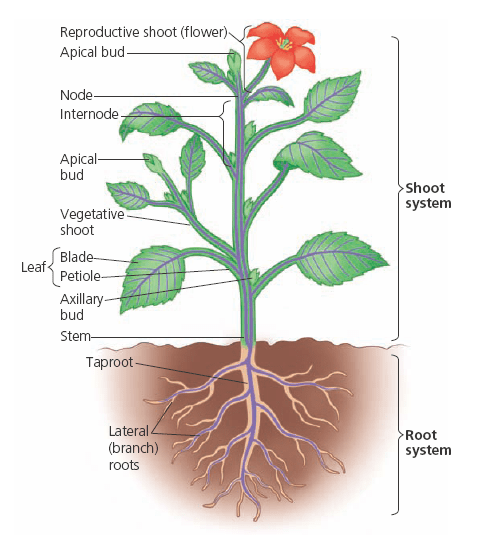Morphology of Flowering Plants
.1 The Root
- The roots that originate from the base of the stem are
(a)fibrous roots
(b) primary roots
(c) prop roots
(d) lateral roots.(NEET 2020)
- Sweet potato is a modified
(a)stem
(b) adventitious root
(c) tap root
(d) rhizome. (NEET 2018)
- Roots play insignificant role in absorption of water in
(a)pea
(b) wheat
(c) sunflower
(d) Pistia. (2015)
- Pneumatophores are found in
(a)the vegetation which is found in marshy and saline lake
(b)the vegetation which found in acidic soil
(c)xerophytes
(d)epiphytes. (2000)
- The plant, which bears clinging roots, is
(a)screw pine
(b) Podostemon
(c) Trapa
(d) orchid. (1999)
- Velamen is found in
(a)roots of screwpine
(b)aerial and terrestrial roots of orchids
(c)leaves of Ficus elastica
(d)aerial roots of orchids. (1991)5.2
EXPLANATION
- (a) : In monocotyledonous plants, the primary root is short lived and is replaced by a large number of roots. These roots originate from the base of the stem and constitute the fibrous root system, e.g., wheat plant.
- (b) : Sweet potato (Ipomoea batatas) is swollen single root tuber that does not assume a definite shape. It is a modified adventitious root for storage of food.
- (d) : Pistia (water lettuce) is a floating aquatic plant. In aquatic plants, roots are generally poorly developed and do not take part in absorption of water. Water is absorbed by the general body surface in these plants.
- (a) : These special roots, called pneumatophores or knees, develop in mangrove plants, i.e., plants growing in saline marshes. These roots grow vertically upward and are negatively geotropic. Air enters these roots through minute breathing pores called pneumathodes, present on the tips of vertical roots. These plants include Rhizophora, Heritiera, Avicennia, etc.
- (d) : Clinging roots arise from the nodes of stem and penetrate the stem of the host plant. It helps in fixing the plant to the host. It is found in orchids. Orchids bear three types of roots – clinging roots for fixation, absorbing roots for absorbing mineral salts and water and epiphytic roots for absorbing moisture from air.
(d) : Velamen is found in aerial roots of orchids. In many epiphytic orchids, the aerial roots are covered by a hygroscopic velamen tissue. They absorb water from the atmosphere.
flowering plants are some of the most fascinating aspects of biology, and if you’re preparing for your NEET exam, it’s essential that you understand their morphology. This guide provides a comprehensive overviewFloweri of flower types and sample questions about them, so you’ll be prepared for whatever the test throws at you!
What is the difference between monocot and dicot flowers?
Monocot and dicot flowers differ in several ways. Monocots tend to have more petals which are spirally arranged with leafy bracts. Dicots, on the other hand, have typically four or five petals that are arranged in opposite directions with a calyx surrounding them. Additionally, monocot flowers often have multiple ovules at each node while dicots will only have one. Lastly, monocots have parallel veins in their leaves while dicots have net-like patterns.

